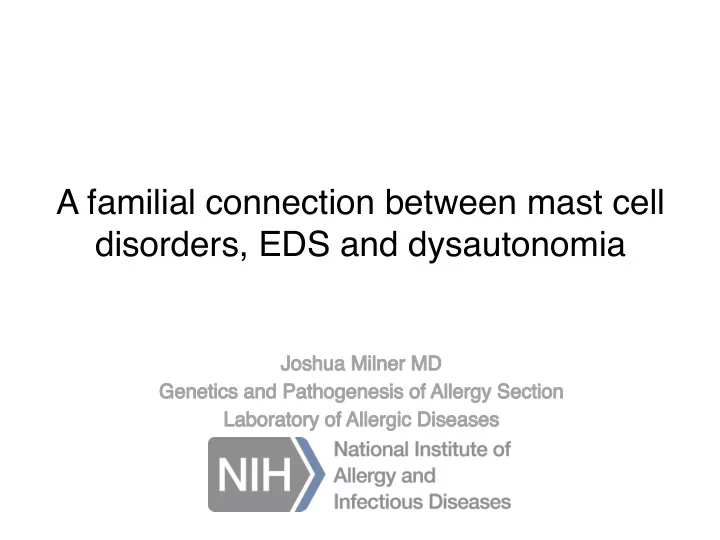

A familial connection between mast cell disorders, EDS and dysautonomia �
What is serum Tryptase? � • A mast cell content that we can measure when mast cells become activated � • When is it high typically? � – After an allergic reaction (anaphylaxis)– only temporarily � – Mastocytosis- having too many mast cells � – Mast cell activation syndromes (MCAS) �
Horny et al. Dtsch. Arztebl. Int . 2008 � Carter, et al. Anesth Analg . 2008 �
AD familial tryptasemia: 30 families and counting � i. � ii. � iii. � iv. � v. � vi. � vii. � viii. � ix. � + 14 � x. � xiii. � xv. � xii. � ? � xiv. � xvi. � xi. � Lyons ¡et ¡al. ¡ J. ¡Allergy ¡Clin. ¡Immunol . ¡2014 ¡ ¡
Familial hypertryptasemia � • Skin � – Recurrent flushing, itching, swelling, hives � • Connective Tissue � – Joint laxity, retained childhood teeth, scoliosis, etc. � • Allergy � – Anaphylaxis, Bee sting allergy, nonallergic food, drug and smell reactions � • Gastrointestinal � – Episodic pain, fecal urgency, IBS, reflux, dysmotility, gallbladder issues � • Neuropsychiatric � – Dysautonomia, Anxiety/ Depression, Pain, Behavior issues � Lyons ¡et ¡al. ¡ J. ¡Allergy ¡Clin. ¡Immunol . ¡2014 ¡
Prevalence of high tryptase in the general population � n ¡= ¡420 ¡ 4.3% ¡(n ¡= ¡18): ¡>11.4ug/L ¡ ¡ Gonzalez-Quintela. Clin Chem Lab Med. 2010 �
Fellinger ¡et ¡al. ¡ Allergol ¡Immunopathol. ¡ 2014 ¡
How do we treat these families? � • Very similar to mast cell activation syndrome patients � – Antihistamines (e.g. allegra), ranitidine (zantac), cromolyn sodium (gastrocrom), aspirin, omalizumab (xolair), steroids � – Biofeedback � – Consult with GI, genetics, cardiology (for dysautonomia) �
Concluding points � • A specific syndrome of high tryptase, symptoms of mast cell activation, EDS-like symptoms and dysautonomia can run in families in a dominant fashion. � • Many of these symptoms can be seen in families who do not have elevated serum tryptase � • Our ongoing research is to find the single genetic cause of this, in the hopes of identifying a target to treat. � • In the meantime, management is symptomatic, not magic! �
Acknowledgements & Thanks � NIH, NIAID, LAD � � Jon Lyons � � Chi Ma � Royal Manchester Xiaomin Yu � Children's Hospital � Guangping Sun � Peter Arkwright � Kendal Karpe � � Michael O’Connell � Cincinnati Children’s Celeste Nelson � Hospital � Nina Jones � Marc Rothenberg � Tom DiMaggio � J. Pablo Abonia � � Andrew Lindsley � NIH, NIA � � Clair Francomano � Virginia Commonwealth Nazli McDonnell � University � � Lawrence Schwartz � NIH, NIDDK � � Theo Heller � Support � Nancy Ho � NIAID DIR � � Merck � NIMH � Maryland Pao � � �
Recommend
More recommend